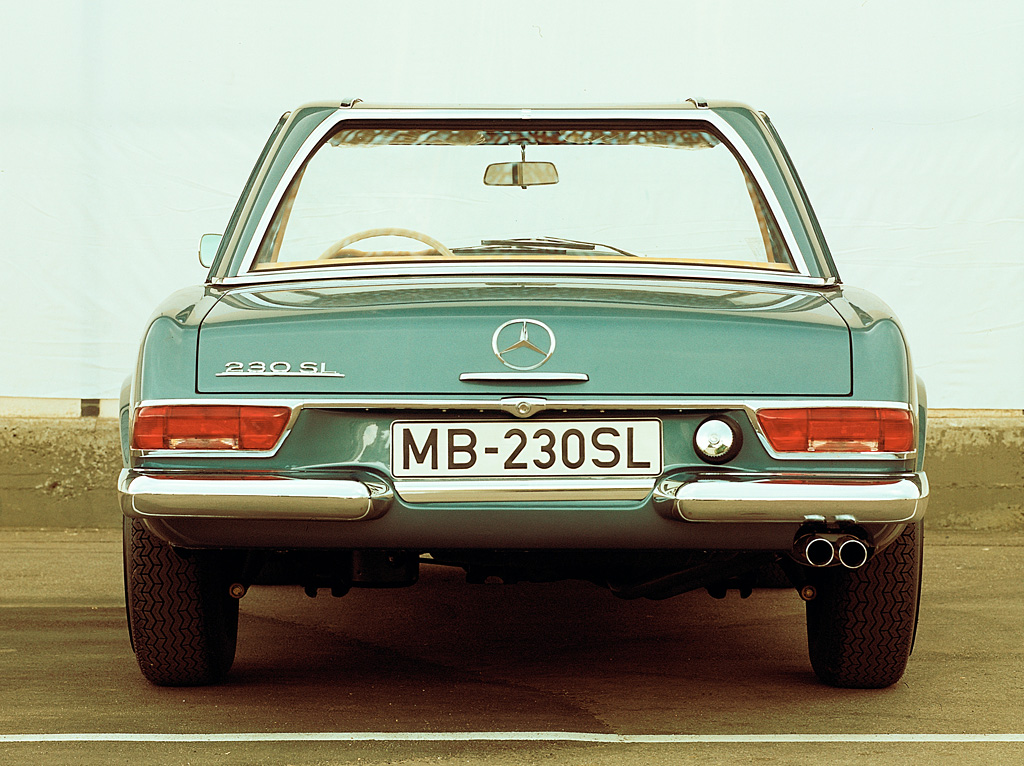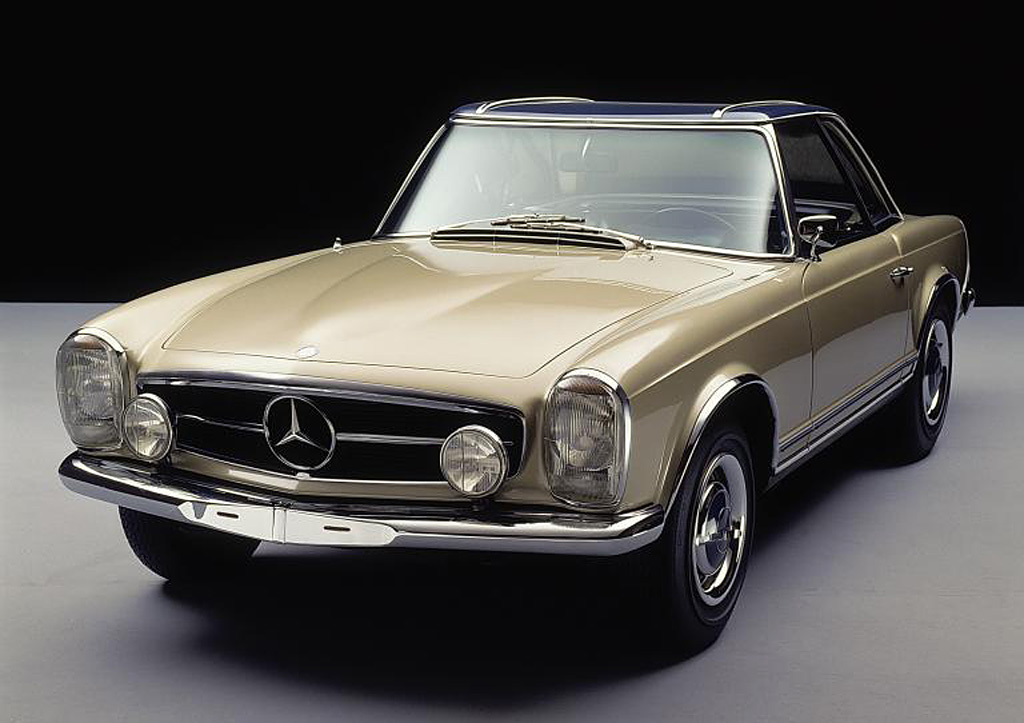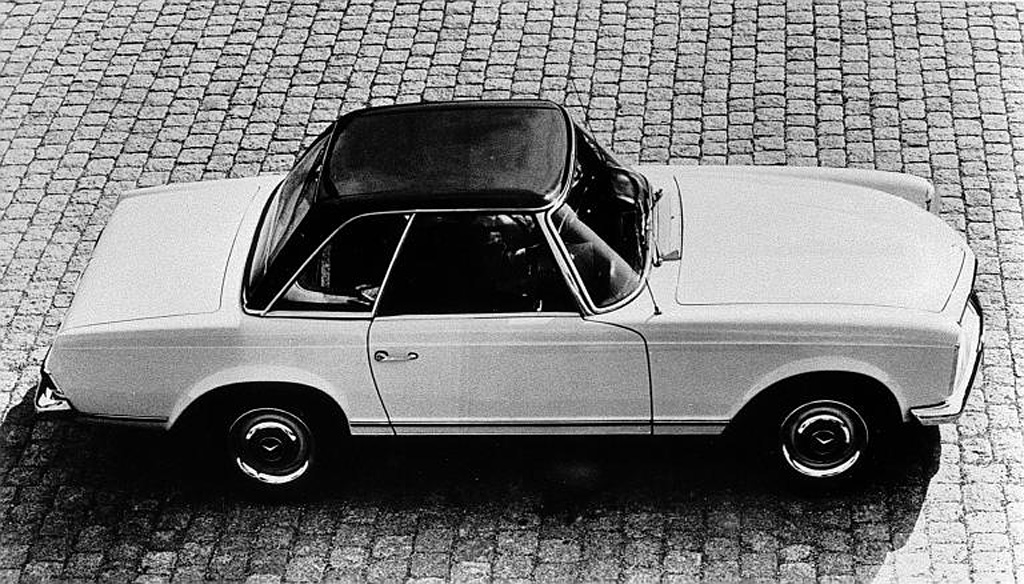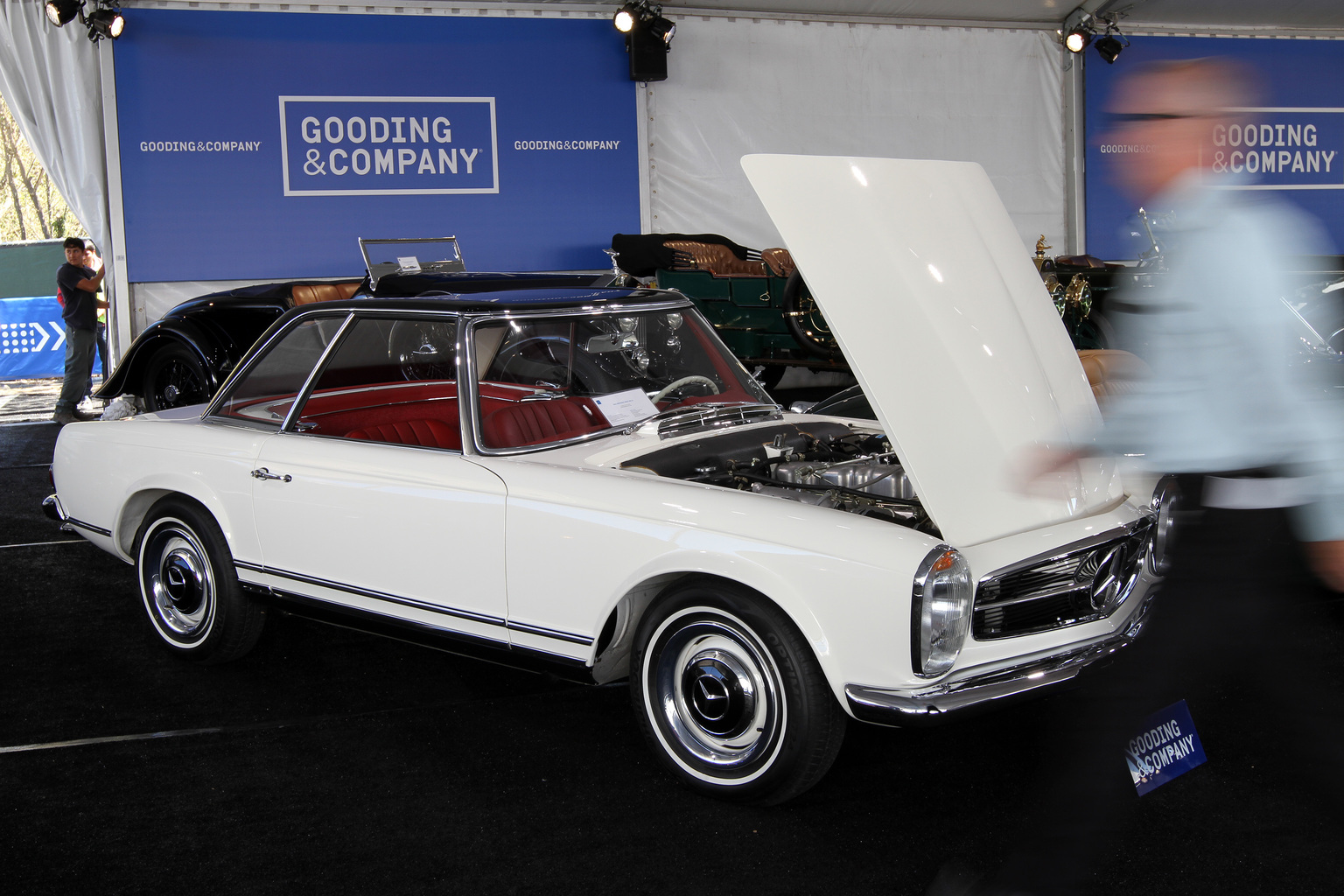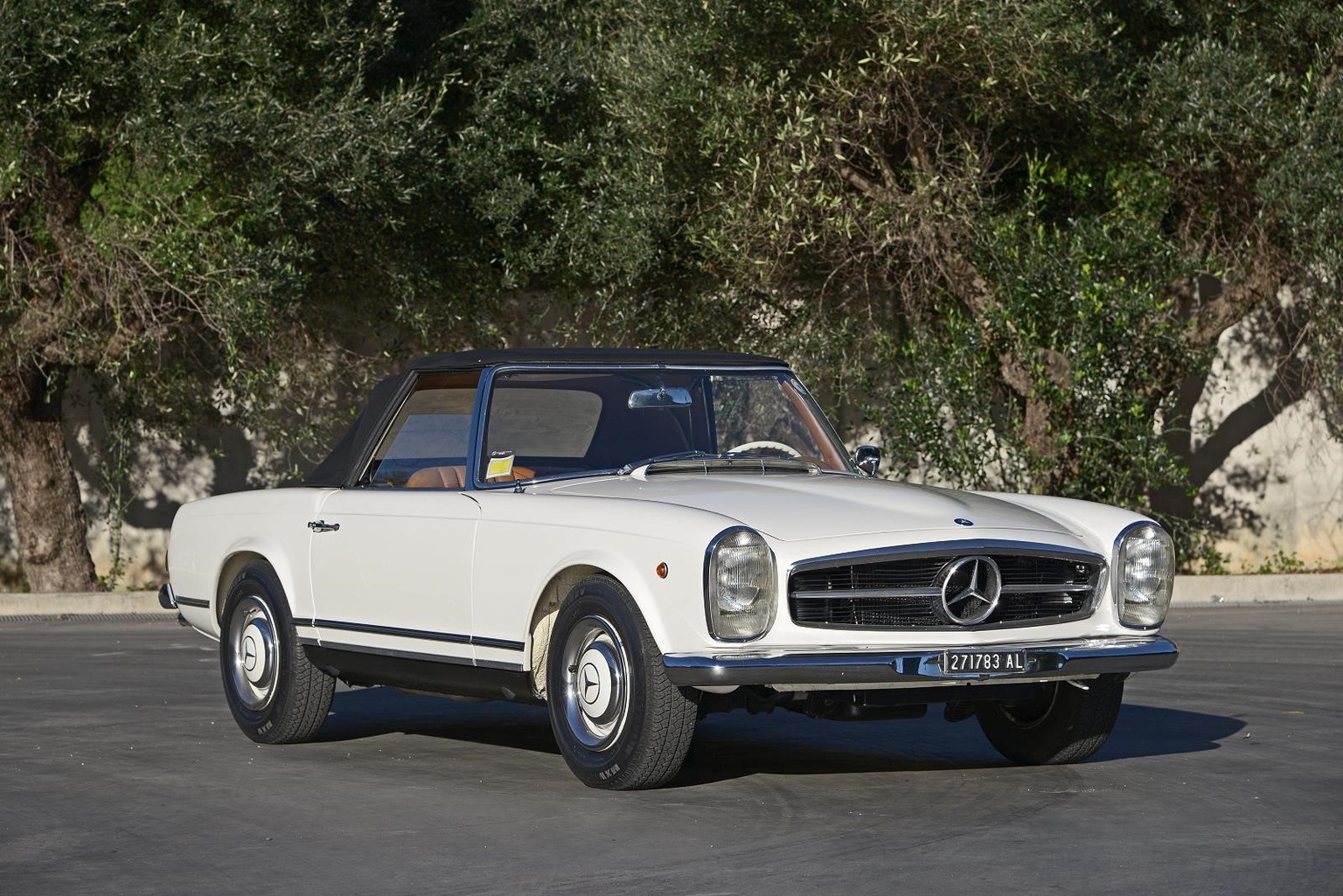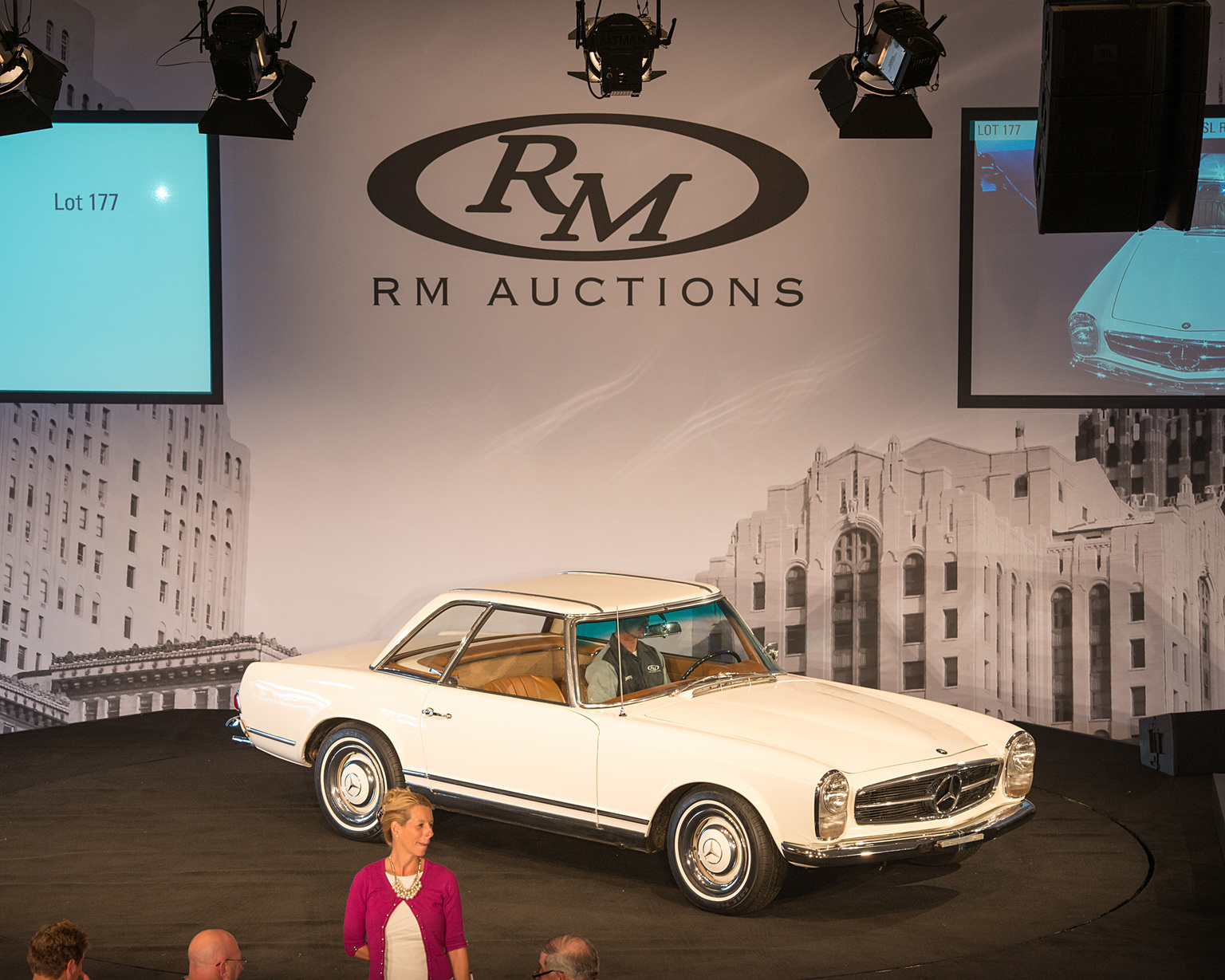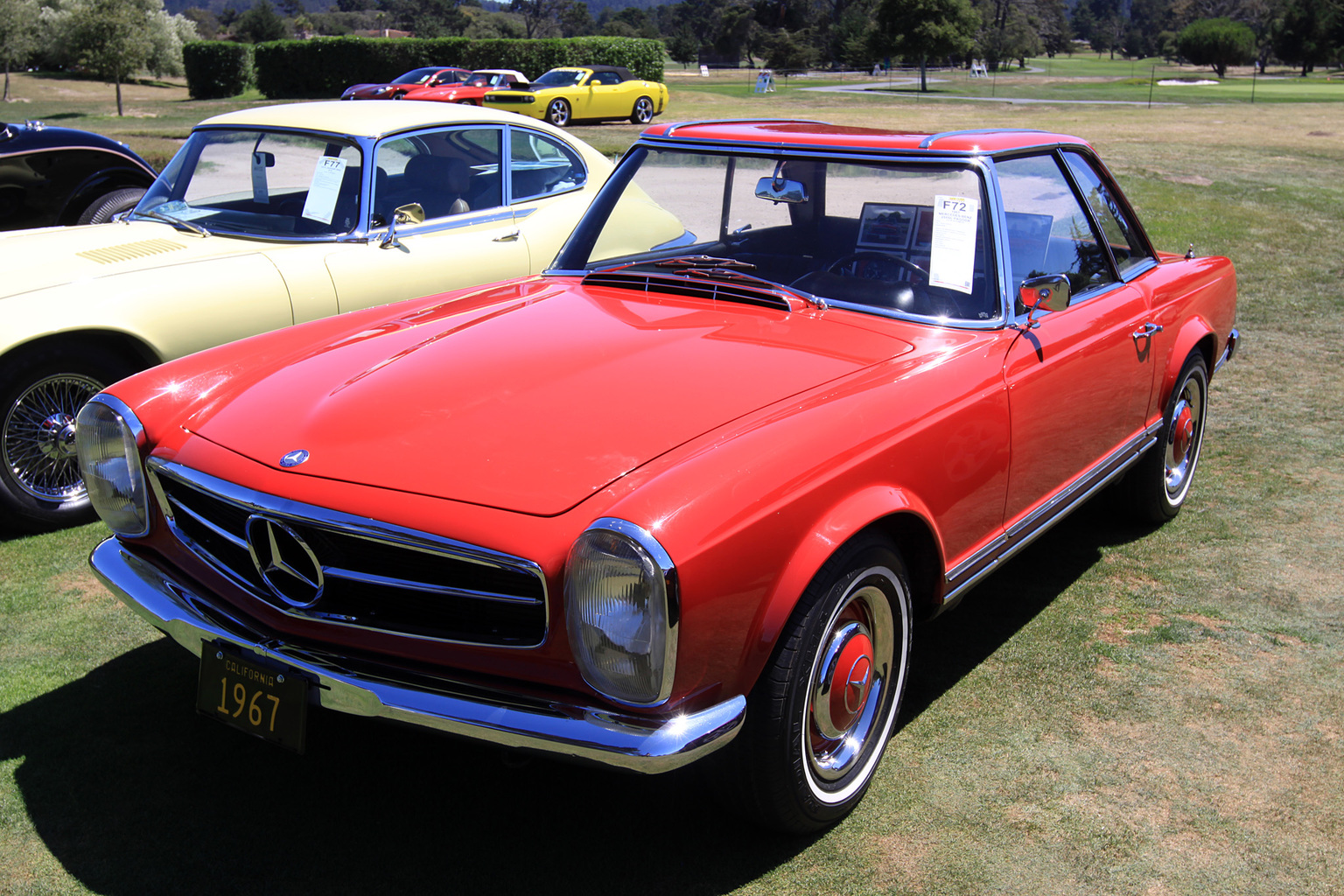1963→1967 Mercedes-Benz 230 SL
The Geneva Motor Show of March 1963 was the scene of a remarkable and well-regarded première: Daimler-Benz presented the Mercedes-Benz 230 SL, a new sports car to replace two models of the previous sales range. Its two predecessors, the 190 SL (W 121) and 300 SL (W 198), were extremely popular and successful from the start. The 300 SL in particular was already a living legend.
The new model took a middle course between the concepts of the 190 SL and the 300 SL: the 230 SL, internally designated as W 113 series, held the balance between the sporty tuning of a classic roadster but added to them the comfort of a two-seater touring car featuring high performance and the most advanced features for optimum driving safety.
The 230 SL was available from summer 1963 in three versions: an open-top car with a folding soft top that could be operated with the greatest of ease – that in itself was a minor sensation; an open-top version with hardtop, and finally as hardtop coupé. The hardtop coupé had no soft top and soft-top compartment, but more room for luggage instead. All three versions could be driven with the top open. As an optional extra a rear transverse seat was available, as in the 190 SL.
The exterior of the 230 SL was characterised by clear, straight lines and the unmistakable SL face including the large, centrally positioned Mercedes star. The bonnet had a slight additional bulge in the middle to provide space for the vertically-installed six-cylinder engine. The boot was generously dimensioned. The hardtop with high windows and a roof borne up only by slim pillars conveyed an impression of lightness which simply did not match the stereotype of a sports car. With its inwardly-directed curvature it reminds one of Far Eastern temples, and straightaway the car had a nickname before it really even hit the road: “Pagoda”. In addition, because of its shape the hardtop made it easier to get in and out of the car.
Apart from the wheelbase – the magic number of 2400 millimetres was taken unchanged from the 190 SL and 300 SL models – the new SL had practically nothing in common with its two predecessors. All the same, the W 113 series was not an entirely new design since its technical concept largely conformed to that of the 220 SE (W 111/3). The SL used the “tailfin” frame-floor assembly, albeit shortened and reinforced, including front and rear wheel suspension.
In addition to the standard four-speed manual transmission, for the first time in an SL a four-speed automatic transmission was available as an optional extra. A five-speed manual transmission produced by Zahnradfabrik Friedrichshafen (ZF) was added as third variant in May 1966.
Safety is the new word
The “Pagoda” was the first SL in which sporty speed combined with safety as a design objective. Since its basis was the floor unit of the famed “Tailfin”, the world’s first saloon with a safety body, this SL also had a rigid passenger cell and crumple zones in the form of easily deformable front and rear segments. This design went back to engineer Béla Barényi, responsible for many of the safety features in cars of the Mercedes-Benz brand. As in the saloon the interior was designed so as to reduce injury hazards in accidents, by eliminating hard corners and edges. As in the previous model, seat belts were available as an optional extra. The steering gear was moved from the crash-imperilled front section to the firewall; the steering column yielding to axial compression and additionally featuring a joint that prevented the feared lance effect in an accident. In 1967, the telescoping safety steering column and the impact absorber in the steering wheel were added.
Chassis, engine, and transmission
The chassis, adopted from the 220 SE (W 111) Saloon, was tuned to the requirements of the sporty car, featuring recirculating ball steering, a dual-circuit brake system and disc brakes on the front wheels. The suspension was taut, but for a sports car almost atypically comfortable. Damping was provided by gas-filled shock absorbers, and for the first time a Mercedes-Benz passenger car rode on radial-ply tyres.
The six-cylinder engine, which also came from the saloon, underwent several major changes, the most important of which was the transition from a two-plunger injection pump to a six-plunger unit. This made it possible to “shoot” the fuel directly through the preheated intake port and the opened intake valves into the combustion chamber, and not just into the intake pipe, as before. The M 127 II engine, its bore enlarged to give it a displacement of 2.3 litres, thus developed 150 bhp (110 kW) at 5500 rpm and delivered torque of 196 newton metres at 4200 rpm. Designed very sportily, this drive unit for the SL delighted in high engine speeds but did not take so kindly to underrevving.
The four-speed transmission, likewise from the saloon construction kit, was designed with a slightly lower ratio in 1st gear to achieve sportier acceleration. It sprinted from 0 to 100 km/h in 9.7 seconds. The top speed of the fabric-roofed 230 SL was 200 km/h, the hard-top version only marginally lower at 196 km/h. The variant with the optional automatic transmission reached a top speed of 195 km/h. In the eyes of sports car purists the automatic is almost immoral. But history teaches us a different lesson: by the time the “Pagoda” was discontinued the automatic transmission’s share was around 77 per cent. It was much the same with the power steering that was also available at extra cost. The W 113 series was a pioneer also on that score: all subsequent SL models always pair exceptionally good performance with highest levels of comfort. The respectable number of 19,831 units of the 230 SL were built.
In Detail
| tags | w113, 230sl, pagoda |
| submitted by | Richard Owen |
| type | Series Production Car |
| production years | 1963 – 1937 |
| built at | Germany |
| production | 19831 |
| engine | M130 Inline-6 |
| valvetrain | SOHC 2 Valves / Cyl |
| fuel feed | Mechanical Injection |
| displacement | 2308 cc / 140.8 in³ |
| bore | 82 mm / 3.23 in |
| stroke | 72 mm / 2.83 in |
| compression | 9.3:1 |
| power | 150.1 kw / 150 bhp @ 5500 rpm |
| specific output | 64.99 bhp per litre |
| bhp/weight | 115.83 bhp per tonne |
| torque | 196 nm / 144.6 ft lbs @ 4200 rpm |
| driven wheels | Front Engine / RWD |
| curb weight | 1295 kg / 2855 lbs |
| wheelbase | 2400 mm / 94.5 in |
| front track | 1486 mm / 58.5 in |
| length | 4305 mm / 169.5 in |
| width | 1758 mm / 69.2 in |
| height | 1308 mm / 51.5 in |
| transmission | 4-Speed Manual |
| final drive | 3.69:1 |
| top speed | ~200 kph / 124.3 mph |
| 0 – 60 mph | ~10.5 seconds |
| 0 – 100 kph | ~9.7 seconds |
Auction Sales History
Ivory White 1963 Mercedes-Benz 230 SL 113.042.10.000024 – sold for $209,000 The Very First 230 SL Delivered in North America. Initially Used as a Factory Demonstrator in Canada. Ivory White, Red Leather Interior, Black Soft and Hard Tops. Accompanied by Receipts Dating to Original Owner, Original Tools, and Owner’s Manual. Show-Quality Restoration in Original Colors 2,306 CC SOHC Inline 6-Cylinder Engine Bosch Mechanical Fuel Injection 148 HP at 5,5
Auction Source: The Pebble Beach Auctions 2015 by Gooding and Company
1965 Mercedes-Benz 230SL Convertible – sold for €89,700 This beautifully restored 230 SL was delivered new in 1965 to its first owner in the province of Alessandria in Northern Italy. Its specification includes a factory hardtop, the desirable manual gearbox and tan upholstery. Currently forming part of an exclusive Southern Italian collection, the Mercedes was subject to a comprehensive restoration circa 2008 and is described as in generally excellent condition. Since the restoration the car has b… read more
Auction Source: The Mercedes-Benz Sale 2015 by Bonhams
1965 Mercedes-Benz 230SL Convertible 113.042.10.010549 – sold for €36,800 This manual transmission 230SL was delivered new to the USA where it is known to have been owned by a Mr Howard Allen Willingham of Davidsonville, Maryland in 1989. In 2014 the 230SL was exported from the USA to the Netherlands and in July of last year was registered in Belgium by its current owner. A selection of photographs of it participating in various ‘fun’ rallies is in the history file.
Auction Source: 2015 Les Grandes Marques du Monde au Grand Palais
1963 Mercedes-Benz 230 SL ‘Pagoda’ 113.042.10.000532 – sold for €123,200 First-year example; fully restored in 2013. Includes owner’s and Becker radio manuals. Beautiful and iconic Pagoda-roofed SL.
Auction Source: 2015 Paris by RM Auctions
1967 Mercedes-Benz 230 SL Roadster 113.042.12.019190 – sold for $52,250 Recent restoration by Dragone Classic Motorcars. Includes both convertible and removable hardtop. Equipped with an automatic transmission and its original Blaupunkt radio. One of only 185 Mercedes-Benz 230 SLs produced for 1967.
Auction Source: 2014 Motor City Auction by RM
1967 Mercedes-Benz 250SL Pagoda Rare 2+2 Seating – sold for $44,500 Rarest of the Mercedes-Benz Pagoda tops. California coupe 2+2 seating, low production. Pagoda roof SL. Fuel injected. Restored transmission recently completed. Mechanically restored. Fresh paint. New interior. Power steering. Optional removable Pagoda hardtop.
Auction Source: The Daytime Auction in Monterey by Mecum
1967 Mercedes-Benz 230SL – sold for $46,000 1967 Mercedes 230SL. Estate car out of long term storage. One careful repaint in the original code 31 Horizon Blue. 80,203 miles actual. Automatic transmission. Air conditioning. Blaupunkt AM/FM radio. Convertible top. Original owners manual, service booklet, Blaupunket radio instructions and factory tag for wheel changing, all still in original plastic folder. Recent repairs include new factory carpet, correct top, water pump and radiator flush, new battery, alternator and new radial tires. Parts identification manual.
Auction Source: The Daytime Auction in Monterey by Mecum





